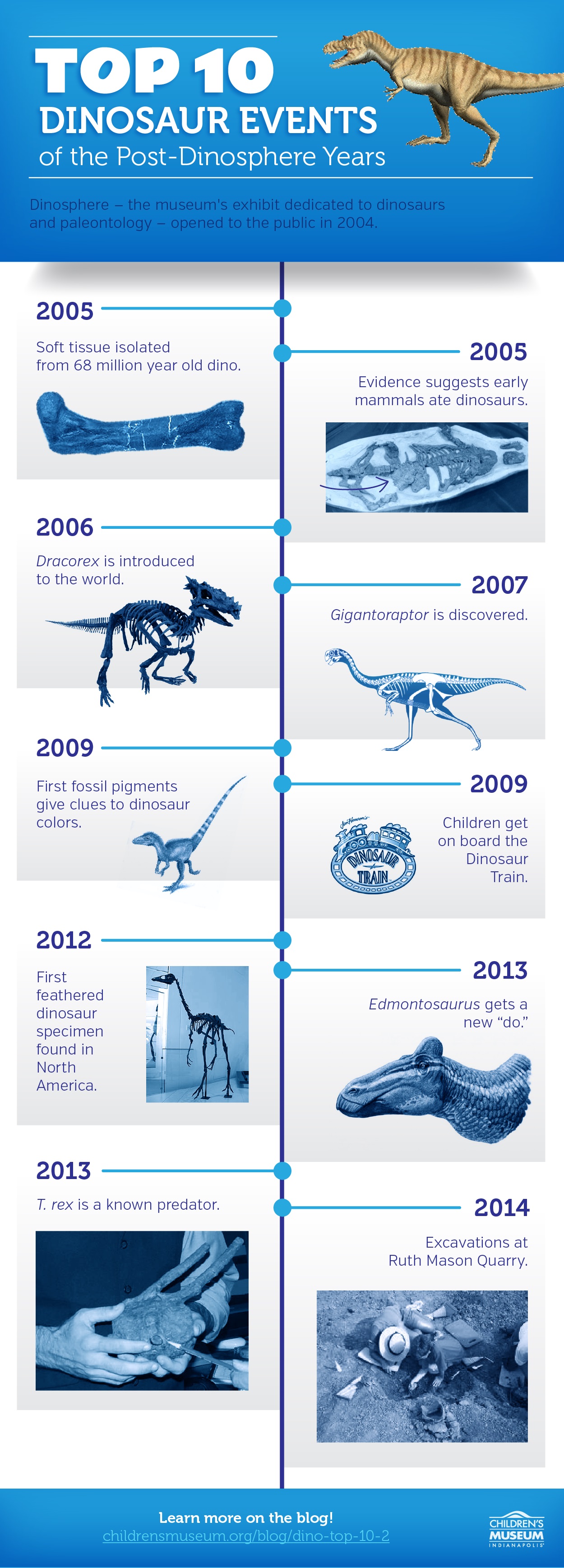
Has this happened to you? You think you know a lot about dinosaurs, and then you're surprised to learn that your favorite didn't even exist! Paleontologists are making new discoveries all the time, keeping us dinosaur fans on our toes. Curious if there's big news that you missed? To celebrate Dinosphere's 10th birthday, we've compiled the top 10 dinosaur events AFTER to Dinosphere's grand opening.
Don't miss the first post in this series, the Top 10 Dinosaur Events of the Pre-Dinosphere Years.
By Paleontologist and Natural Science Curator Dallas Evans.
1. 2005 — Scientist isolates soft tissue from a 68 million year old dinosaur.
Dr. Mary Schweitzer became one of the first scientists to use the tools of modern cell biology to investigate dinosaurs. Upon examining the thighbone of a T. rex she discovered remnants of soft tissues hidden away within the interior of the bone.
2. 2005 — Evidence is unearthed that early mammals ate dinosaurs.
Excavations in China provide the first direct evidence that early mammals preyed upon dinosaurs. Inside the skeleton of the early mammal Repenomamus, researchers find the preserved remains of a young Psittacosaurus!
3. 2006 — Dracorex is introduced to the world.
Unearthed in the badlands of South Dakota, this new species of dinosaur is given the name Dracorex hogwartsia, or “Dragon king of Hogwarts” thus delighting generations of both dinosaur and Harry Potter fans.
4. 2007 — Gigantoraptor is discovered.
Chinese paleontologist Dr. Xing Xu announces the discovery of Gigantoraptor erlianensis, a 3000 pound, toothless raptor that stalked the Late Cretaceous of Inner Mongolia.
5. 2009 — First fossil pigments give clues to dinosaur colors.
Researchers find fossilized melanosomes, the remains of pigments, in the feathers and protofeathers of dinosaurs and birds from China. For the first time we're given the possibility of finding out what color some dinosaurs may have been!
6. 2009 — Children get on board the Dinosaur Train.
The Jim Henson Company introduces an animated series for preschool children featuring a young T. rex named Buddy. Perhaps the best thing about this series is the appearance of well know paleontologist Dr. Scott Sampson, who encourages children to learn natural history, to be thrilled by scientific exploration and to investigate paleontology.
7. 2012 — The first feathered dinosaur specimen is found in North America.
The relationship between dinosaurs and birds was proposed in the late 1800s by anatomist Thomas Huxley. In the 1990s, well preserved fossil specimens of feathered dinosaurs were being excavated in China. However in 2012 Canadian researchers discovered the first evidence of a feathered dinosaur from North America—an ostrich-like dinosaur called Ornithomimus. These dinosaurs would have been just too large to fly, so the feathers may have served another purpose, like attracting a mate or protecting eggs during hatching.
8. 2013 — Edmontosaurus gets a new "do."
One of the most familiar of duck-billed dinosaurs may have looked much differently than we've always assumed. Researchers noticed fossil traces of a crest on top of the skull of an Edmontosaurus. Not the boney structure of the skull, but evidence of preserved soft tissue. This was a dinosaur with a cock’s comb—that's right, like a rooster!
9. 2013 — T. rex is a known predator.
Was T. rex a scavenger or predator? That question has been asked for many years until it was definitively answered. Researchers discovered the vertebra of an injured duckbill dinosaur. The backbone had a broken T. rex tooth embedded in it. Not only was the dinosaur bitten by a T. rex, but there were signs that the wound was healing. So the duck-billed dinosaur survived the attack!
10. 2014 — Excavations at Ruth Mason Quarry.
Of course we have to brag a little bit,… this year marks a dozen years of excavating at the Ruth Mason Quarry near Faith, South Dakota. In that time we've excavated thousands of Edmontosaurus bones and introduce hundreds of families to the thrill of paleontology.

 (
(










